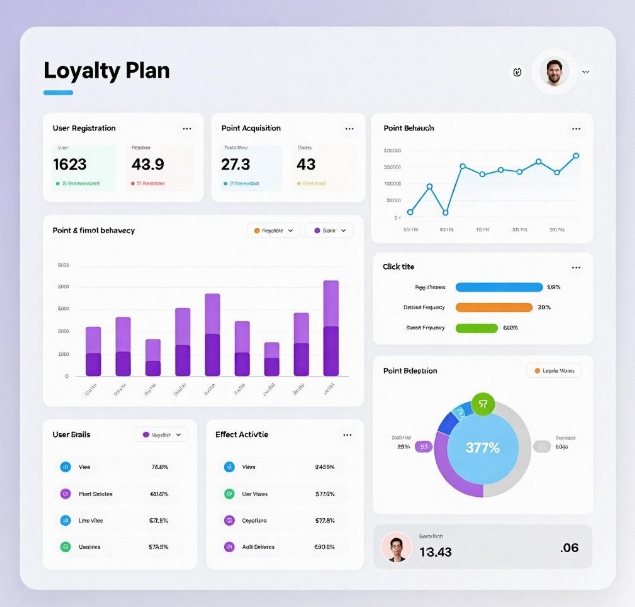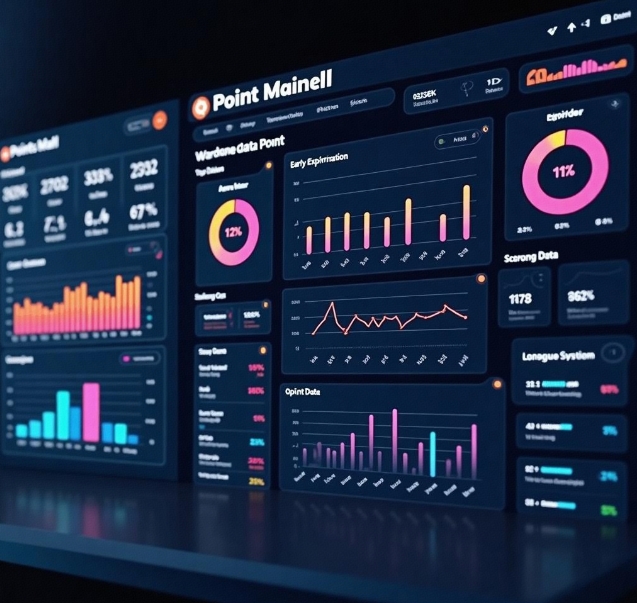How to Set and Track Data Metrics for a Points Mall?
- latest articles
- 1.DApp Development & Customization: Merging Diverse Market Needs with User Experience 2.Analysis of the Core Technical System in DApp Project Development 3.How to achieve cross-chain interoperability in Web3 projects? 4.How does the tokenization of points reconstruct the e-commerce ecosystem? 5.How to Set and Track Data Metrics for a Points Mall? 6.What is DApp Development? Core Concepts and Technical Analysis 7.Inventory of commonly used Web3 development tools and usage tips 8.Development of a Distribution System Integrated with Social E-commerce 9.Six Key Steps for Businesses to Build a Points Mall System 10.What is DApp Development? A Comprehensive Guide from Concept to Implementation
- Popular Articles
- 1.Future Trends and Technology Predictions for APP Development in 2025 2.Analysis of the DeFi Ecosystem: How Developers Can Participate in Decentralized Finance Innovation 3.From Zero to One: How PI Mall Revolutionizes the Traditional E-commerce Model 4.DAPP Development | Best Practices for Professional Customization and Rapid Launch 5.Recommended by the Web3 developer community: the most noteworthy forums and resources 6.From Cloud Computing to Computing Power Leasing: Building a Flexible and Scalable Computing Resource Platform 7.Shared Bike System APP: The Convenient Choice in the Era of Smart Travel 8.How to Develop a Successful Douyin Mini Program: Technical Architecture and Best Practices 9.How to Create a Successful Dating App: From Needs Analysis to User Experience Design 10.From Design to Development: The Complete Process of Bringing an APP Idea to Life
With the rapid development of the e-commerce industry, points malls, as a common tool for enhancing customer loyalty, have been widely adopted by major enterprises. Points malls not only boost user activity and enhance customer stickiness but also effectively help merchants understand customer needs and optimize operational strategies through data analysis. However, how to effectively set up and track the data metrics of a points mall is a topic that every e-commerce platform and operations team needs to deeply consider.
This article will delve into the methods for setting up and tracking data metrics for points malls, helping businesses optimize points mall operations, enhance user experience, and improve business performance from a data-driven perspective.
I. The Significance and Functions of Points Malls
Before delving into the setup of data metrics, we first need to clarify the role of points malls. A points mall is not only a place for consumers to redeem goods and services but also a bridge for interaction between merchants and users. Through points malls, merchants can achieve the following functions:
Enhance Customer Loyalty: Through the points redemption mechanism, merchants can attract users to participate frequently, thereby increasing customer stickiness.
Incentivize Purchasing Behavior: Points malls encourage consumers to make purchases by setting points rules, prompting users to conduct more transactions within the mall.
Facilitate Marketing Campaigns: Points malls can serve as part of promotional activities, stimulating user participation in various campaigns through points rewards to achieve sales targets.
Collect User Behavior Data: The transaction and interaction behaviors in points malls provide merchants with a wealth of user data, helping them better understand consumer needs and preferences.
To effectively achieve the above goals, merchants need to conduct precise operations and adjustments based on data. The setup and tracking of data metrics are the foundation for achieving this objective.
II. How to Set Up Data Metrics for Points Malls?
When setting up data metrics for points malls, we first need to clarify several core questions: Which metrics can reflect the operational effectiveness of the mall? How to select key data metrics suitable for one's own mall? The answers to these questions will provide a basis for subsequent operational decisions.
Below are some common and important data metrics for points malls. Merchants can select and adjust them according to their own needs.
1. User Registration Volume and Activity
User registration volume and activity are fundamental metrics for measuring the popularity of a points mall. Merchants should regularly track these metrics to understand user registration and activity on the platform.
Number of New Registered Users: Indicates the number of newly registered users within a certain period, reflecting the platform's appeal.
Number of Active Users: Refers to the number of users who have performed at least one points-related action (such as earning or redeeming points) within a specific time frame.
Daily/Weekly/Monthly Activity Rate: Measures the frequency of user activity within a specified time period.
2. Points Earned
Points earned refers to the amount of points accumulated by users in the mall, which directly reflects the activity level of the points mall. Merchants should adjust the ways points are earned based on different activities and marketing strategies to incentivize user consumption.
Average Points Earned: The average number of points earned by users within a certain period.
Sources of Points Earned: For example, earning points through purchases, participating in activities, check-ins, etc.
3. Points Redeemed
Points redeemed refers to the total amount of points users exchange for goods or services. This metric directly reflects user activity and the actual value of the platform's points.
Redemption Rate: The ratio of successfully redeemed points to the total points earned, reflecting how users utilize their points.
Average Redemption Value: The value of points redeemed per transaction, helping merchants assess the appeal of the points mall and product pricing.
4. User Retention Rate
User retention rate is a key metric that indicates whether users remain active over a certain period. A high retention rate means users are satisfied with the points mall and are willing to participate long-term.
Day 1 Retention Rate: The retention rate of new users on the day after registration.
Week 1 Retention Rate: The retention rate of new users on the seventh day after registration.
Month 1 Retention Rate: The retention rate of new users on the thirtieth day after registration.
Through user retention data, merchants can gauge the stickiness of the points mall and determine whether optimizations to the points system are needed to improve retention rates.
5. Conversion Rate
Conversion rate refers to the percentage of users who visited the points mall and completed a points redemption or participated in other related activities within a certain period. This data reflects the marketing effectiveness of the points mall and the level of user engagement.
Overall Conversion Rate: The proportion of users who completed a points redemption among all visitors to the mall.
Specific Conversion Rate: Such as the participation conversion rate for a particular campaign.
6. Points Expiration and Loss
Points expiration and loss refer to points that were not used by users within the validity period, thus becoming invalid. This metric is crucial as it reflects the issue of points becoming "invalid" in the points mall.
Points Expiration Rate: The proportion of points that expired within a certain period relative to the total points.
Amount of Points Lost: Refers to the number of points that users failed to use during the campaign or redemption period.
III. How to Track Data Metrics for Points Malls?
After setting up appropriate key data metrics, merchants need to accurately track and analyze them to understand trends and make real-time adjustments. Below are several commonly used data tracking methods and tools.
1. Data Analysis Platforms
Merchants can use third-party data analysis platforms (such as Google Analytics, Mixpanel, etc.) to track and analyze data from points malls. These platforms provide detailed user behavior data, conversion path analysis, and real-time reports.
Through data analysis platforms, merchants can:
View user behavior paths and analyze user activities within the points mall.
Monitor key metrics such as points earned and redeemed.
Track the effectiveness of marketing campaigns in real-time and evaluate their success.
2. Custom Data Reports
Many points mall platforms allow merchants to customize data reports, regularly generating operational data that meets their specific needs. These reports can include:
Daily/weekly/monthly user activity reports.
Comprehensive data on points earned and redeemed.
Specific performance data for various promotional activities.
Through custom reports, merchants can more accurately grasp the operational status of their points malls.
3. Real-time Monitoring and Alert Systems
To ensure the continuous and efficient operation of the points mall, merchants can set up real-time monitoring systems to keep an eye on data fluctuations. For example, when anomalies occur in the points mall (such as a sharp drop in redemption rates or a surge in expired points), the system can alert operations personnel to handle the issue promptly.
4. User Surveys and Feedback
In addition to data tracking, merchants can also understand users' genuine opinions about the points mall through user surveys and feedback. Conducting regular user satisfaction surveys and collecting suggestions and feedback help optimize the design and operation of the points mall.
IV. Optimization and Adjustment of Data Metrics
Based on the tracked data, merchants can optimize and adjust the operations of their points malls. Common optimization directions include:
Optimize Points Earning Rules: Adjust the difficulty of earning points based on user participation to enhance user engagement.
Enhance the Appeal of Points Redemption: Regularly introduce attractive redemption items or services to increase the redemption rate.
Optimize Marketing Campaigns: Adjust the design of promotional activities based on conversion rate data to improve marketing effectiveness.
Address Points Expiration Issues: Reduce points expiration and loss by setting points validity periods or regularly reminding users to use their points.
Conclusion
As an important component of e-commerce platforms, the operational effectiveness of points malls directly impacts customer loyalty and merchant revenue. By reasonably setting up and meticulously tracking data metrics, merchants can obtain precise user behavior data, helping to optimize the operational strategies of points malls, enhance user experience, and improve platform profitability.
Through data-driven decision-making, points malls are no longer just simple points redemption venues but become vital tools for merchants to interact with users, enhance customer stickiness, and drive sales. Merchants should continuously summarize experiences, optimize the methods for tracking and analyzing data metrics, and ensure the sustainable development and profit growth of their points malls.
-

How does the tokenization of points reconstruct the e-commerce ecosystem?
With the continuous advancement of internet technology and the gradual prolifera···
-

How to Set and Track Data Metrics for a Points Mall?
With the rapid development of the e-commerce industry, points malls, as a common···
-

Development of a Distribution System Integrated with Social E-commerce
With the rapid development of internet technology, the e-commerce industry has e···

 Blockchain
Blockchain












